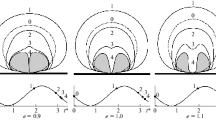Abstract
The resonant motion of a compressible bubble in an acoustic field is numerically investigated by using a level-set method, which is extended to examine compressible two-phase flows of air and weakly compressible liquid water. Computations are performed for bubble motion on a solid surface that is exposed to a periodic pressure wave. Numerical results show that the resonant bubble motion is significantly magnified by the surrounding compressible liquid when a specific height is reached. The effects of liquid height, contact angle, and bubble size on the oscillation amplitudes of bubble radius and pressure are quantified.
Similar content being viewed by others
References
J. L. Bull, The application of microbubbles for targeted drug delivery, Expert Opinion on Drug Delivery, 4 (2007) 475–493.
C. C. Coussios and R. A. Roy, Applications of acoustic and cavitation to noninvasive therapy and drug delivery, Annual Review of Fluid Mechanics, 40 (2008) 395–420.
A. Prosperetti, Bubble phenomena in sound fields: Part on, Ultrasonics, 22 (1984) 69–77.
W. C. Moss, Understanding the periodic driving pressure in the Rayleigh-Plesset equation, Journal of the Acoustic Society in America, 101 (1997) 1197-1190.
L. Yuan, H. Y. Cheng, M. C. Chu and P. T. Leung, Physical parameters affecting sonoluminescence: a self-consistent hydrodynamic study, Physical Review E, 57 (1998) 4265–4279.
D. Fuster, C. Dopazo and G. Hauke, Liquid compressibility effects during the collapse of a single cavitating bubble, Journal of the Acoustic Society in America, 129 (2011) 122–131.
C. E. Brennen, Cavitation and bubble dynamics, Cambridge University Press, New York, USA (2014).
Z. Cui, Y. Li, Y. Ge and L. S. Fan, Bubble modulation using acoustic standing waves in a bubbling system, Chemical Engineering Science, 60 (2005) 5971–5981.
G. Huber, S. Tanguy, J. C. Bera and B. Gilles, A time splitting projection scheme for compressible two-phase flows, application to the interaction of bubble with ultrasound waves, Journal of Computational Physics, 302 (2015) 439–468.
S. Majidi and A. Afshari, A ghost fluid method for sharp interface simulations of compressible multiphase, Journal of Mechanical Science and Technology, 30 (2016) 1581–1593.
H. Terashima and G. Tryggvason, A front-tracking/ghostfluid method for fluid interfaces in compressible flows, Journal of Computational Physics, 228 (2009) 4012–4037.
H. Lu, J. Shu, D. Wang and N. Zha, Runge Kutta discontinuous Galerkin method with front tracking method for solving the compressible two-medium flow, Computers & Fluids, 126 (2016) 1–11.
R. P. Fedkiw, T. Aslam, B. Merrima and S. A. Osher, A non-oscillatory Eulerian approach to interfaces in multimaterial flows (the ghost fluid method), Journal of Computational Physics, 152 (1999) 457–492.
R. P. Fedkiw, Coupling an Eulerian fluid calculation to a Lagrangian solid calculation with the ghost fluid method, Journal of Computational Physics, 175 (2002) 200–224.
A. Osterman, M. Dular and B. Sirok, Numerical simulation of a near-wall bubble collapse in an ultrasound field, Journal of Fluid Science and Technology, 4 (2009) 210–221.
J. Lee and G. Son, A sharp-interface level-set method for compressible bubble growth with phase change, International Communications in Heat and Mass Transfer, 86 (2017) 1–11.
J. Lee and G. Son, A level-set method for ultrasound-driven bubble motion with a phase change, Numerical Heat Transfer Part. A: Applications, 71 (2017) 928–943.
S. Cho, G. Son and S. Kim, Numerical analysis of bubble motion under a pressure pulsing condition, Journal of Mechanical Science and Technology, 31 (2017) 5897–5904.
S. Y. Kadioglu, M. Sussman, S. Osher, J. P. Wright and M. Kang, A second order primitive preconditioner for solving all speed multi-phase flows, Journal of Computational Physics, 209 (2005) 477–503.
M. Jemisona, M. Sussman and M. Arienti, Compressible, multiphase semi-implicit method with moment of fluid interface representation, Journal of Computational Physics, 279 (2014) 182–217.
N. Kwatra, J. Su, J. T. Gretarsson and R. Fedkiw, A method for avoiding the acoustic time step restriction in compressible flow, Journal of Computational Physics, 228 (2009) 477–503.
S. W. Rienstra and A. Hirschberg, An introduction to acoustics, Eindhoven University of Technology, Eindhoven, Netherlands (2004).
L. E. Kinsler, A. R. Frey, A. B. Coppens and J. V. Sanders, Fundamentals of acoustics, John Wiley & Sons, New York, USA (1982).
Author information
Authors and Affiliations
Corresponding author
Additional information
Recommended by Associate Editor Hyoung-gwon Choi
Jaewon Lee received his B.S. degree in mechanical engineering from Sogang University in 2013. He is currently a Ph.D. student of mechanical engineering at Sogang University in Seoul, Korea. Lee’s research interests include microfluidics and multiphase dynamics with phase change.
Gihun Son received his B.S. and M.S. degrees in mechanical engineering from Seoul National University in 1986 and 1988, respectively, and his Ph.D. degree in mechanical engineering from UCLA in 1996. Dr. Son is currently a Professor of mechanical engineering at Sogang University, Korea. His research interests include heat transfer, multiphase flows, and power plants.
Rights and permissions
About this article
Cite this article
Lee, J., Son, G. Numerical simulation of bubble resonance in an acoustic field. J Mech Sci Technol 32, 1625–1632 (2018). https://doi.org/10.1007/s12206-018-0317-3
Received:
Revised:
Accepted:
Published:
Issue Date:
DOI: https://doi.org/10.1007/s12206-018-0317-3



